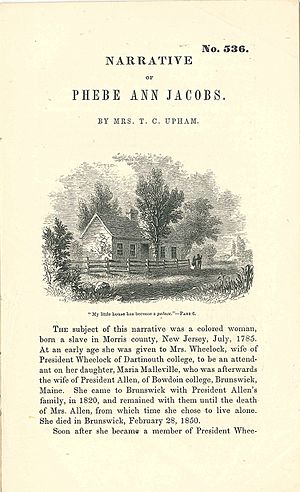Phebe Ann Jacobs facts for kids
Quick facts for kids
Phebe Ann Jacobs
|
|
|---|---|

The first page of Narrative of Phebe Ann Jacobs
|
|
| Born | 1785 Hanover Township, New Jersey, now Parsippany Troy Hills
|
| Died | February 28, 1850 |
| Nationality | American |
Phebe Ann Jacobs (born 1785, died 1850) was an American woman who was born into slavery. She later became a free woman. Phebe was also a Congregationalist and worked as a laundress. She is best known because of a book written about her life after she died. This book was called Narrative of Phebe Ann Jacobs.
Phebe Ann Jacobs was born on a large farm called Beverwyck plantation. This farm was in Lake Hiawatha, New Jersey. During her life, she was enslaved by families connected to important colleges. These included the president of Dartmouth College and later the president of Bowdoin College in Brunswick, Maine. In her last years, she gained her freedom. She then worked in Brunswick, washing clothes for students at Bowdoin. In 1919, the New Jersey Historical Society said Jacobs was important. They admired her strong Christian faith and her dedication.
Early Life and Enslavement
Phebe Ann Jacobs was born in 1785. She was born into slavery on the Beverwyck plantation. This plantation was located in Lake Hiawatha, New Jersey. Phebe did not go to school. Instead, she was trained to work in a home as a domestic servant. She had a sister named Peggy. Other people likely enslaved Peggy. The names of Phebe's parents are not known from historical records.
When Phebe was a child, she was enslaved by Maria Malleville. Maria was the daughter of President Wheelock of Dartmouth College. Maria Malleville was born in 1788. This means Maria was three years younger than Phebe.
On January 28, 1813, Maria Malleville married William Allen. William Allen later became the president of Bowdoin College in Brunswick, Maine. At this time, Phebe was 28 years old. She continued to be enslaved by the Allens. They moved to their new home in Pittsfield, Maine.
Some records suggest that Phebe became free in Maine. However, her freedom was not simple. A history professor named James J. Gigantino II explained her situation. He said that like many free Black people, Phebe kept working for her former owners. Even though she was free, she faced racism. It was also hard for her to find other jobs.
Later Years and Freedom

Phebe Ann Jacobs likely stayed with the Allen family for a long time. This might have been due to a type of agreement called indentured servitude. She remained with them until her enslaver, Maria Allen, passed away.
For the last years of her life, Phebe lived on her own. She earned money by washing and ironing clothes. Her clients were students from Bowdoin College. She lived in a small cabin in Pine Grove. This area was a blueberry plain. Today, it is where an airport is located.
Around 1850, Phebe met Phebe Lord Upham. They might have met at the First Parish Church. Upham was a theologian, a poet, and a social activist. She was known for her book The Crystal Fountain. Upham was from Kennebunkport. She was married to a Bowdoin professor named T. C. Upham. Around this time, Upham may have started writing Phebe Jacobs's life story. Some sources say the story was "dictated." This means Phebe Jacobs likely told Upham her life experiences. Upham then wrote them down.
Phebe Ann Jacobs died in Brunswick on February 28, 1850. She passed away from a heart condition.
Lasting Impact
Phebe Jacobs's funeral had many people attending. The Times Record newspaper reported on it. It said the First Parish Congregational Church was full. People wanted to honor their friend and fellow citizen. Maine Governor Robert Pinckney Dunlap was one of the people who helped carry her coffin. Someone even noted that Phebe Ann Jacobs's funeral had as many people as Joshua Chamberlain's funeral.
The Allen family, relatives of Phebe's former enslaver, also attended. They were told about her death by telegraph. The Allens traveled more than 200 miles to be at Phebe's funeral.
In 1850, after Phebe's death, Upham finished a small book about her life. It was called Narrative of Phebe Ann Jacobs, also known as Happy Phebe. It was published in London in 1850. The story also appeared in The Oberlin Evangelist in September 1850. The American Tract Society in New York published it in 1850 and again in 1854. Bowdoin College states that the book tells about Jacobs's life after she gained freedom. It also highlights her strong faith. However, it does not fully describe the hard work of being enslaved.
In 1854, a book from Edinburgh advertised Jacobs's story. It was part of a collection of pamphlets for schools. It was sold with other stories like "John Rock, the Miner."
Around 1850, Phebe Jacobs's biography inspired author Harriet Beecher Stowe. Stowe wrote her famous anti-slavery novel Uncle Tom's Cabin in 1852.
In 2010, Phebe Jacobs was added to the Brunswick Women's History Walking Trail. She is honored alongside other important women. These include explorer Miriam MacMillan and author Harriet Beecher Stowe.
In 2021, Jacobs's story was part of an art exhibition at Bowdoin College. The exhibition was called There Is a Woman in Every Color: Black Women in Art. It was shown during Black History Month.

